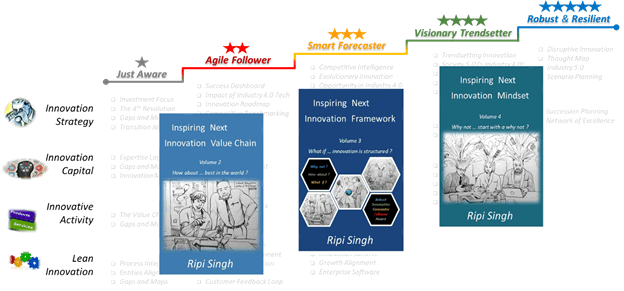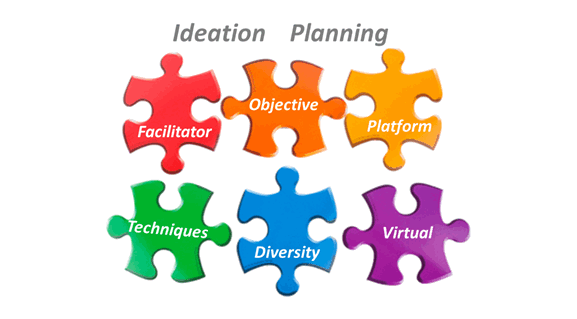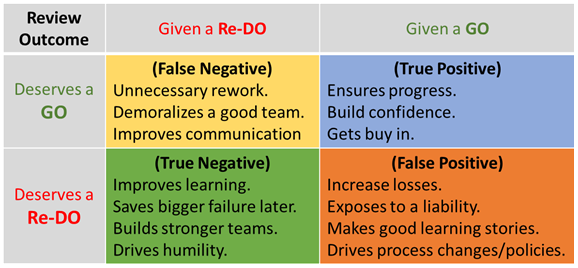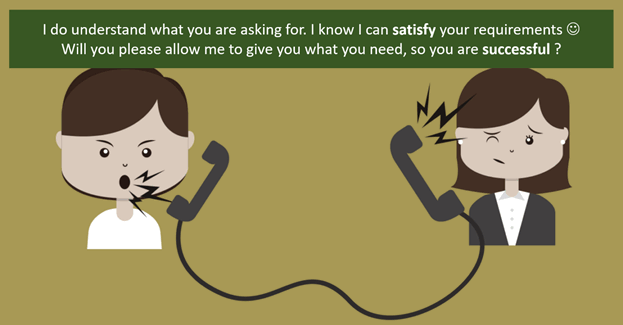How Innovative is your Organization?
Really?
It is very much possible to have a structured process to innovate consistently.
Just a few years ago, I was grappling with this question, and dancing around the possible hypothesis in futile attempt to convince my superiors on the preferred innovation investment opportunities. I wish I had this framework a decade ago while leading advanced technology for fortune 500 companies.

What is your Innovation Profile?
Can we assign stars to how good is your organization in innovating, just like we assign stars to movies, hotels, books, and shopping cart items? Of course, you can, and give yourself **** saying there is always room for improvement. Here is our definition that we have successfully applied over the last 5 years.
Aware (*): These are the companies that have successfully innovated and know how to. They just cannot sustain it for one of the many reasons.
Agile Follower (**): These companies innovate in response to market demand and successfully compete on cost and time to market. They are listening to the customers, and benchmark themselves against the competition.
They want to know “What” and are good at “How”.
Smart Forecaster (***): These companies innovate in anticipation of market demand and try to be amongst the first few in the marketplace to easily recover their investment. They empathize with the customer to understand the unarticulated needs and invest in competitive intelligence to predict their moves.
They ask “Why” in addition to their understanding of “What” and “How”.
Visionary Trendsetter (****): These companies innovate and create a demand. They educate the customers on why and how of their offerings, while making the competition irrelevant.
They start with “Why Not”.
Robust & Resilient (*****): These are the trendsetters, who have also built so much talent, knowledge, branding, and cash reserves that they can absorb any emerging disruption, even if they missed a trendsetting scenario.
With this simplistic definition, you should be able to see where you are and where you want to be.
Building your Innovation Profile
To move from one profile to another, you need to progressively create a strategic roadmap, and systematically build the expertise to create innovative offerings. Numerous best practices can be categorized under 4 tracks, and they change with profile. So a 5×4 matrix of framework is what helps companies build an innovation profile and the culture of innovation.
Innovation Strategy: Defines what products and services would a company develop with timeline to capture the market share. Set of tools progressively add rigor to the roadmap through Benchmarking, Portfolio balancing, Project prioritization, Competitive intelligence, Smart forecasting, and Scenario based planning.
Innovation Capital: Defines what Talent, Knowledge, Assets, and IP, are required when to support the innovation strategy. Set of tools guide subject matter expertise & leadership development, High performance team building, Knowledge augmentation, leveraging networks, Succession planning; all using novel visual maps.
Innovative Activity: Defines the process to systematically develop new products, reducing risk and cost. The Basis is a 5-step innovation value chain from ideation to monetization. This guides the team through white space or a market demand, and ends with an emotionally engaged customer, passing through risk and cost reduction check points.
Lean Innovation: Aligns products, processes, employees, customers, and business metrics, to continuously improve the efficiency and productivity of the enterprise. This set of tools guide the employee morale and customer engagement to support management objectives.
A case for Innovation Framework
A significant value contributed by the framework comes from sequence, dependence, and integration, where tools use a common set of parameters and indicators across the enterprise. This enables employees to break through the silos and ceilings, holding the company growth. The fact that everyone talk same language, works from the same page, provides synergy benefits making the whole greater than sum of individual pieces.
Innovation Mindset
If you are happy with yesterday, you are not likely to do anything new today.
In addition to processes and tools, you also need to build the next mindset. “The innovation killers are almost always neatly disguised as protectors of the organization” says Thomas Koulopoulos.
Struggle to Innovate
There are several reasons holding executives back from taking steps to create innovation-driven differentiation to change their destiny. Some highly visible aspects include leadership mindset – quarter to quarter performance, incentives, risk-averse style, too much familiarity with the market, etc. The keys steps to change the organizational mindset are show here.

Unshackle the Past
Initiatives such as six-sigma which add value to repeatable activities such as manufacturing, are not particularly suited for new product development. Lean helps with productivity, and perhaps innovation at the process level, not so much at ideation for content or creative outcomes. When people say, innovation is unaffordable; I ask “Do you know the cost of not innovating?
Reboot Leadership
Innovation leadership is about creating a space, where people are willing and able to work hard, share, and combine talent and passion to innovatively solve a problem. Innovation leaders are open to rapid continuous change, willing to take risks, embrace the iterative nature of innovation, align innovation strategy with overall business purpose, stay out of the way of people innovating, accept failure, and build communities that enjoy exploration. Leaders understand that ultimately, innovation is more about mindset than skill set, a mental muscle rather than handcraft.
Re-ignite Creativity
If we agree that innovation is a mental muscle, then we accept that it needs a regular workout, a conscious effort, several activities that over some time can build the mental muscle. These include inspiring everyday language, weekly innovation minute in staff meetings, quarterly open ideation competition, hackathons, and an annual innovation summit or open day. Hiring an innovator is trickier than we think. A typical hiring process, which is designed to quickly eliminate potential low performers, also ends up identifying an innovator as a misfit. Promoting an innovator comes with a challenge on people skills and might require a dual career path for retention.
Embrace Exploration and Accept Failures
Researchers in basic science know that a large percentage of experiments will fail, and every failure conveys valuable information, and they are eager to get it before the competition does. On the other side, the corporate managers, vary of failure, typically do whatever they can to make sure that the test is perfect right out from the start. Exceptional organizations recognize failure as a necessary by-product of exploration. They also realize that they do not have to do big experiments with large budgets. Often a small pilot, a dry run of a new technique, or a simulation will suffice. Failures are a significant contributor to building a strong character, confidence, and a believable personality. I have a difficult time working with those, who claim they have never failed. Either the claim is false, or the explorer in them is non-existent. In addition to subject matter learning, failure breaks down our egos, and promotes team bonding and integrity.
Please Appreciate
Innovation capability development is a long and hard journey to build the mental muscle. Just like building the physical muscle requires regular visits to the gym, proteins for months, adequate rest, and a coach; The mental muscle requires discipline, consistency, commitment, patience, and coaching. Once you are on your way, please give this muscle enough time and energy to develop.
In Summary,
Innovation can be structured, and organizations innovation profile can be built to address strategic growth objectives. It is not a magic. Although it is not a perfect science either. It is probably partly art and partly sports. Requiring practice and building the mental muscle
If you like this blog post, you will like my books – “Inspiring Next Innovation Framework” available on Amazon. and “Inspiring Next Innovation Mindset” available on Amazon.
If you wish to engage with the author of these two book in a conversation, please register for online sessions scheduled for March 18, and April 1 2021 at 9AM ET co-hosted by Nerac.



